
The Holmen Church is a Parish church in central Copenhagen in Denmark, on the street called Holmens Kanal. First built as an anchor forge in 1563, it was converted into a naval church by Christian IV. It is famous for having hosted the wedding between Margrethe II of Denmark, queen of Denmark between 1972 and 2024, and Prince Henrik in 1967. It is the burial site of such notabilities as naval heroes Niels Juel and Peter Tordenskjold, and composer Niels Wilhelm Gade, and contains artwork by, among others, Bertel Thorvaldsen and Karel van Mander.

Damsholte Church, located in the village of Damsholte on the island of Møn in southeastern Denmark, is the only village church in the country built in the Rococo style. It is considered to be one of Denmark's finest Rococo buildings.

Svaneke Church is located in the small town of Svaneke on the Danish island of Bornholm. It stands above the harbour at a height of 18 metres on the site of a small chapel which appears to have existed for quite some time before the town received its charter in the 16th century. The church was expanded over the years, the tower and spire being completed in 1789. In 1881, virtually the whole building was rebuilt by architect Mathias Bidstrup of Rønne, leaving only the tower and a small section of the south wall.

Østermarie Church, in the village of Østermarie near Svaneke on the Danish island of Bornholm, was originally built in the early 13th century. While it was being demolished in 1890, it was discovered it was of considerable architectural interest and work was stopped. The new church from 1891 is also in the Romanesque style.

The Church of Our Lady in Assens is located on (Fyn). It is a Church of Denmark parish church.

St. Canute's Church is a Romanesque church located 3 km northeast of Rønne on the Danish island of Bornholm.

Aastrup Church, located on the top of a steep hill in the village of Aastrup, 6 kilometres (3.7 mi) southwest of Stubbekøbing on the Danish island of Falster, dates from c. 1200. Built in the Late Romanesque style, it has frescos from the 13th and 15th centuries.

Stubbekøbing Church is located in Stubbekøbing some 18 km (11 mi) northeast of Nørre Alslev on the Danish island of Falster. The basilical nave was built of limestone in the Late Romanesque period. Choir and tower are of brick, the choir built in Early Gothic style, tower and the northern chapels in the 15th century in Late Gothic style. In addition to its Renaissance altarpiece and pulpit, it has a variety of old frescos and wall decorations (1300–1500).

The Trinitatis Church is located in central Copenhagen, Denmark. It is part of the 17th century Trinitatis Complex, which includes the Rundetårn astronomical observatory tower and the Copenhagen University Library, in addition to the church. Built in the time of Christian IV, the church initially served the students of Copenhagen University. It is situated at the corner of Landemærket and Købmagergade. The interior was seriously damaged in the fire of 1728 but was rebuilt in 1731.

Eskilstrup Church is a church in Eskilstrup, Denmark. The church dates from the 12th century and was built in the Romanesque style. In accordance with a local tradition, it is painted red. It is best known for its frescos, said to be Denmark's oldest.

Faxe Church is a Danish church located in the Diocese of Roskilde, in Faxe, Region Sjælland on the island of Zealand. It was built at the end of the 15th century on a site where there had originally been a Romanesque church. A number of frescos, probably painted by artists from the Brarup workshop, have been uncovered on the cross vaults, most recently above the organ.
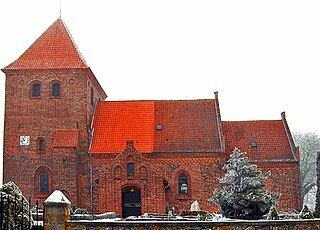
Tågerup Church is a Romanesque parish church located 4 km southeast of Rødby on the Danish island of Lolland. Dating from the beginning of the 13th century, its nave is richly decorated with early 16th-century frescos painted by the Brarup workshop.
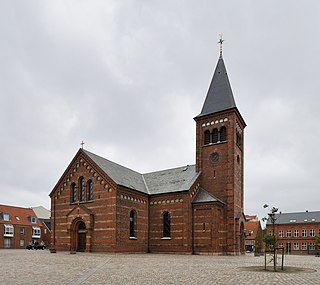
The Church of Our Saviour is a parish church in Esbjerg, Denmark. Completed in 1887 to a design by Axel Møller, it was the first church to be built in the rapidly growing new town.
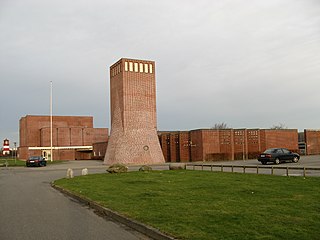
Sædden Church is a church of the Church of Denmark in Esbjerg in the southwest of Jutland, Denmark. Designed by Inger and Johannes Exner, the almost cube-shaped building with a tall, free-standing bell tower was completed and consecrated in 1978.
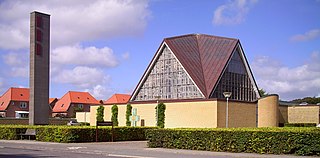
Trinity Church is a modern church in Esbjerg in the southwest of Jutland, Denmark. Designed by local architects Erik Flagstad Rasmussen and Knud Thomsen, the yellow-brick building with large triangular stained-glass windows was completed in 1961.

Grundtvig's Church is a modern church in Esbjerg in the southwest of Jutland, Denmark. Designed by Ole Nielsen of Lyngby, the building of dark red brick with a red-tiled roof was completed in 1969.
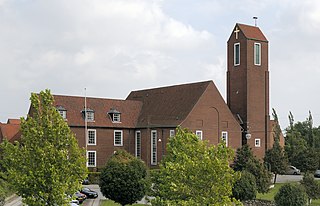
St. Mark's Church is a church located in St. Mark's Parish in Aarhus, Denmark. The church is located in the Midtbyen neighbourhood. It is a parish church within the Church of Denmark servicing a parish population of 8.873 (2015). The church was designed by the Danish architect Thomas Havning who won a public contest for a new church design in 1933. The parish of the Church of Our Lady was reaching a population of 10.000 and it had been decided to split it and create a new parish, requiring a new church. Construction began in 1934 and was completed in October, 1935. The church is dedicated to Mark the Evangelist. In 1982 a new wing, Klostergården, was added to the church with an office and recreational facilities for youth preparing for confirmation. In 1998 the church was extensively renovated.

Saint Peter's Church is a Lutheran church located in the center of Slagelse, Denmark. The congregation was originally part of the Roman Catholic Church, but was converted to Lutheranism during the Reformation.

Købelev Church is a parish church in the village of Købelev on Lolland in southeastern Denmark. It consists of a Late Romanesque chancel and nave and a Late Gothic tower. The poets Poul Martin Møller and Christian Winther grew up in the associated rectory to the west of the church.
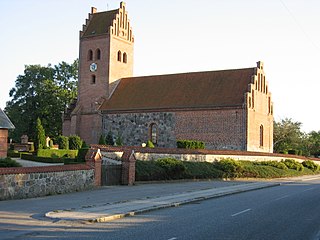
Lillerød Church is a parish church in Lillerød, Allerød Municipality, some 20 km north of central Copenhagen, Denmark.

























